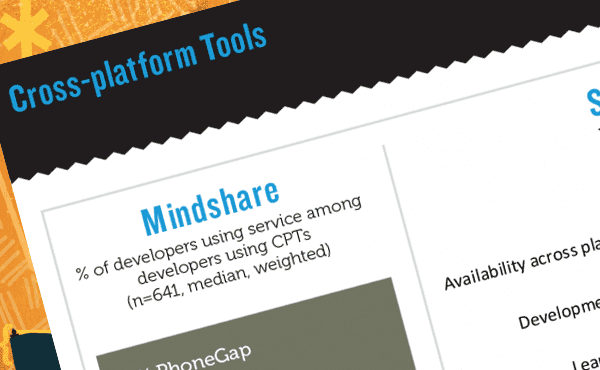
January 30, 2013
Cross-platform tools (CPTs) address real challenges for developers. Cross-platform tools allow developers to create applications for multiple platforms – usually mobile, but increasingly tablets or TV screens – from almost the same codebase or from within the same design tool. CPTs reduce the cost of platform fragmentation and allow developers to target new platforms at a small incremental cost. More importantly, cross-platform tools allow software companies targeting multiple platforms to reuse developer skills, share codebases, synchronise releases and reduce support costs.
CPTs can be used to develop native, hybrid and web apps and come in several technology flavours: JavaScript frameworks, App factories, Web-to-native wrappers, Runtimes and Source code translators. There are over 100 CPTs that we identified in our Cross Platform Tools 2012 report.
Developers most often use several CPTs; on average CPT users will use 1.91 CPTs, confirming the lack of maturity and niche nature of cross platform tools much like we observed in our CPT survey a year ago. Moreover, we found that one in four developers will use more than three cross platform tools. The lack of a one-size-fits-all and immaturity in the CPT landscape is what is stalling cross platform tools from shifting the balance of power in the iOS / Android duopoly towards alternative platforms.
Cross platform tools are most popular for developers focusing on HTML development, with 38% of of them using CPTs for development. CPTs and particularly JavaScript frameworks and Web-to-native wrappers, provide a relatively smooth transition to mobile apps for web developers: in our Cross-Platform Developer Tools 2012 report we found that 60% of developers using CPTs have over 5 years experience in web development. Usage of CPTs is popular among iOS developers, while usage among Windows Phone developers is much lower, presumably due to historical lack of support for the iOS platform from CPT vendors and Microsoft’s financial incentives for the creation of native apps.
PhoneGap tops CPT rankings, used by 34% of developers, followed by Appcelerator and AdobeAir with 21% and 19% developer mindshare respectively. With over 100+ cross platform tools available, the choice for developers can be a challenge. Choosing between CPT technologies is not always straightforward (i.e. whether to go for a web-to-native wrapper or a JavaScript framework). Moreover, developers need to try out a cross-platform tool to see if it aligns with their needs in terms of performance, learning curve, access to native APIs or look & feel. It’s never a black or white decision.
The most important selection criterion for CPTs is their availability across platforms. Due to their deep platform integration, CPT tools support iOS/Android platforms first, and others secondly. Beyond cross-platform availability, 38% of developers using CPTs select their tools based on development speed and 33% based on the learning curve. Since CPTs aim to expedite and facilitate development across platforms, they should provide a clear advantage over native platforms when it comes to speed and ease of development to justify their use. Amidst differentiating features for CPTs are access to native APIs, performance optimisation and the ability to reproduce native UI elements on each platform.
[doritos_report location=’DE13 Article – CPT’]
Which CPTs are other developers using?
[toggle title=”Important things to know about this interactive graph”]
- All the filters in the graph refer to survey questions in which respondents could select multiple answers. This means that there is no direct link between the filter and the use of the tool. For example, filtering on “Android” means that the respondents develop Android apps. It doesn’t imply that they use the tools for their Android apps specifically, or even that the tool supports the Android platform. Use filters as a guideline only.
- Keep an eye on the sample size. If the sample size is low, the graph doesn’t offer strong conclusions about the popularity of different tools. Use your good judgment when making decisions.[/toggle]
Find the best CPT for you!
[sectors slugs=’cross-platform-tools,app-factories,hybrid’]
Recent Posts

August 27, 2025
How to Find the Right Learning Path When You’re Switching to a Tech Career
See post

August 22, 2025
Developer News This Week: AI Speed Trap, GitHub Copilot Agents, iOS 26 Beta Updates & More (Aug 22, 2025)
See post

August 08, 2025
Developer News This Week: GitHub GPT-5, VS Code 1.103 & Chrome 139 (Aug 8, 2025)
See post
